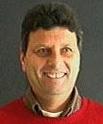|
|
Gilles Aubert
Collaborateur extérieur, UNSA / CNRS
 Projet : ARC DADA Projet : ARC DADA
 Démos : voir les démos de l'auteur Démos : voir les démos de l'auteur
 Contact : Contact :
| E-Mail : | | gaubertatmathdotunicedotfr | | Téléphone : | | (33)4-92-07-62-82 | | Fax : | | (33)4-92-38-76-43 | | Adresse : | | Laboratoire J.A Dieudonne, UMR 6621 CNRS
University of Nice-Sophia Antipolis,
06108 Nice Cedex 2, France | | Site personnel : | | visitez ! |
|

|  Dernières publications dans le projet Ariana : Dernières publications dans le projet Ariana :
A new variational method for preserving point-like and curve-like singularities in 2d images.
D. Graziani et L. Blanc-Féraud et G. Aubert. Dans Proc. IEEE International Conference on Acoustics, Speech and Signal Processing (ICASSP), Prague, Czech Republic, mai 2011.
Mots-clés : Convex optimization, nesterov scheme, laplacian operator.
@INPROCEEDINGS{ICASSP_Graziani11,
|
| author |
= |
{Graziani, D. and Blanc-Féraud, L. and Aubert, G.}, |
| title |
= |
{A new variational method for preserving point-like and curve-like singularities in 2d images}, |
| year |
= |
{2011}, |
| month |
= |
{mai}, |
| booktitle |
= |
{Proc. IEEE International Conference on Acoustics, Speech and Signal Processing (ICASSP)}, |
| address |
= |
{Prague, Czech Republic}, |
| url |
= |
{http://hal.inria.fr/inria-00592603/fr/}, |
| keyword |
= |
{Convex optimization, nesterov scheme, laplacian operator} |
| } |
Abstract :
We propose a new variational method to restore point-like and curve-like singularities in 2-D images. As points and open curves are fine structures, they are difficult to restore by means of first order derivative operators computed in the noisy image. In this paper we propose to use the Laplacian operator of the observed intensity, since it becomes singular at points and curves. Then we propose to restore these singularities by introducing suitable regularization involving the l-1-norm of the Laplacian operator. Results are shown on synthetic an real data.
|
On the Illumination Invariance of the Level Lines under Directed Light: Application to Change Detection.
P. Weiss et A. Fournier et L. Blanc-Féraud et G. Aubert. SIAM Journal on Imaging Sciences, 4(1): pages 448-471, mars 2011.
Mots-clés : Level Lines, topographic map, illumination invariance, Change detection, contrast equalization, remote sensing.
@ARTICLE{SIIMS_2011,
|
| author |
= |
{Weiss, P. and Fournier, A. and Blanc-Féraud, L. and Aubert, G.}, |
| title |
= |
{On the Illumination Invariance of the Level Lines under Directed Light: Application to Change Detection}, |
| year |
= |
{2011}, |
| month |
= |
{mars}, |
| journal |
= |
{SIAM Journal on Imaging Sciences}, |
| volume |
= |
{4}, |
| number |
= |
{1}, |
| pages |
= |
{448-471}, |
| url |
= |
{http://www.math.univ-toulouse.fr/~weiss/Publis/SIIMS_2011_Weiss.pdf}, |
| pdf |
= |
{http://www.math.univ-toulouse.fr/~weiss/Publis/SIIMS_2011_Weiss.pdf}, |
| keyword |
= |
{Level Lines, topographic map, illumination invariance, Change detection, contrast equalization, remote sensing} |
| } |
Abstract :
We analyze the illumination invariance of the level lines of an image. We show that if the scene
surface has Lambertian reflectance and the light is directed, then a necessary and sufficient condition
for the level lines to be illumination invariant is that the three-dimensional scene be developable and
that its albedo satisfy some geometrical constraints. We then show that the level lines are “almost”
invariant for piecewise developable surfaces. Such surfaces fit most of the urban structures. This
allows us to devise a fast and simple algorithm that detects changes between pairs of remotely
sensed images of urban areas, independently of the lighting conditions. We show the effectiveness of
the algorithm both on synthetic OpenGL scenes and real QuickBird images. The synthetic results
illustrate the theory developed in this paper. The two real QuickBird images show that the proposed
change detection algorithm is discriminant. For easy scenes it achieves a rate of 85% detected changes
for 10% false positives, while it reaches a rate of 75% detected changes for 25% false positives on
demanding scenes.
|
A formal Gamma-convergence approach for the detection of points in 2-D biological images.
D. Graziani et G. Aubert et L. Blanc-Féraud. SIAM Journal on Imaging Sciences, 3(3): pages 578-594, septembre 2010.
Mots-clés : points detection, curvature-depending functionals, divergence-measure fields.
@ARTICLE{2,
|
| author |
= |
{Graziani, D. and Aubert, G. and Blanc-Féraud, L.}, |
| title |
= |
{A formal Gamma-convergence approach for the detection of points in 2-D biological images}, |
| year |
= |
{2010}, |
| month |
= |
{septembre}, |
| journal |
= |
{SIAM Journal on Imaging Sciences}, |
| volume |
= |
{3}, |
| number |
= |
{3}, |
| pages |
= |
{578-594}, |
| url |
= |
{http://hal.inria.fr/inria-00503152/}, |
| keyword |
= |
{points detection, curvature-depending functionals, divergence-measure fields} |
| } |
Abstract :
We propose a new variational model to locate points in 2-dimensional biological images. To this purpose we introduce a suitable functional whose minimizers are given by the points we want to detect. In order to provide numerical experiments we replace this energy with a sequence of a more treatable functionals by means of the notion of Gamma-convergence. |
|
 Liste complète des publications dans le projet Ariana
Liste complète des publications dans le projet Ariana
|
|


